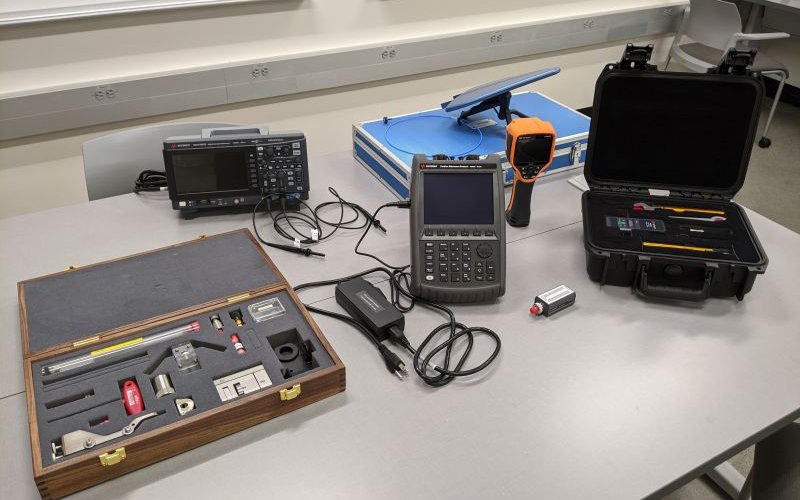2022 MRSL News & Updates

In 2022, the Microwave Remote Sensing Lab received more recognition and accolades, continued its research in new and exciting ways, and upgraded its equipment.
July
Professor Aksoy was featured on Today at UAlbany for his CAREER Award. More information about the research related to this award can be found under the projects section of this page. To read the article about his CAREER Award, click here.
June
Professor Aksoy has won an NSF Faculty Early Career Development (CAREER) Award. This award will focus on modeling electrical properties of ice across wide ranges of frequencies and temperatures and developing efficient interference mitigation algorithms which will enable the next generation of wideband microwave radiometers to fully probe Earth’s ice bodies. In the past 3 years, Professor Aksoy has also received the NASA Space Technology Early Career Faculty and ORAU Ralph E. Powe Junior Faculty Enhancement awards. Congrats Professor Aksoy! Click here to read Professor Aksoy's announcement about the CAREER award.
Imara Nazar from our lab has won the 4th place in the Student Paper Competition at the URSI combined Atlantic/Asia-Pacific Radio Science Conference. It comes with a $250 prize. Congrats Imara!
Over the past week Rahul and Dr. Aksoy have been conducting experiments in the lab to measure the complex permittivity of various materials including water, oil, soil, human skin, and salt. The experiments were conducted using the Keysight Technologies Microwave Analyzer and our Dielectric probe kit. The next step will be test the permittivity of ice for our project “Characterization of the Antarctic Firn by Multi-Frequency Passive Remote Sensing from Space”.
May
Our article titled, "Antarctic Firn Characterization via Wideband Microwave Radiometry" has been published in the Remote Sensing MDPI journal. We utilized the Global Precipitation (GPM) constellation to characterize the Antarctic firn in terms of its physical and thermal properties.The journal is open access, so please check it out.
April
Imara Nazar has been selected as one of ten finalists in the URSI combined Atlantic/Asia-Pacific Radio Science Conference. Her paper, "Radio Frequency Interference Detection in Microwave Radiometry: A Novel feature-based Statistical Approach" discusses novel interference techniques for microwave radiometers. Congrats Imara!
Our lab group at the University at Albany will present 5 papers at the International Geoscience and Remote Sensing Symposium (IGARSS2022) this summer in Malaysia covering various topics in the field of passive microwave remote sensing.
PhD student Imara Nazar from our lab has been admitted into NYU Tandon School of Engineering's Faculty First Look Program. She will discuss her research on radio frequency interference detection and mitigation in passive remote sensing applications.
Check out the Winter 2022 Issue of the Global Space-based Inter-Calibration System (#GCICS) Quarterly Newsletter for our article on the calibration of CubeSat radiometer constellations. We demonstrated a novel approach to calibrate cubeSats in their entirety as a single system. For more information on the Global Space-based Inter Calibration System, click here.
Rahul Kar, a PhD student in our lab, has been awarded the Young Scientist Award from the International Union of Radio Science. He will be presenting his research on remote sensing of the Antarctic firn this summer at the URSI combined Atlantic/Asia-Pacific Radio Science Conference. Also, Dua Kaurejo an undergraduate working with Rahul has been awarded the UAlbany Presidential Award for her research efforts.
The preliminary program of the URSI combined Atlantic/Asia-Pacific Radio Science Conference 2022 is now available. Our lab group will be presenting 3 papers at the conference. Please check them out if you are attending!
March
Our lab board at UAlbany showing some work with Transmission Lines, S-parameters, and the Smith Chart.
February
NASA is soliciting proposals due March 2022 from US for-profit companies to develop cis-lunar, lunar suface, and in-space infrastructure and capabilities. See these two links for more information: Announcement for Partnership Proposals (AFPP) to Advance Tipping Point Technologies and Space Technology Announcement of Collaboration Opportunity (ACO)
Happy International Day of Women and Girls in Science. A large applause to our female colleagues for their contributions to science and technology!
NASA Space Technology Mission Directorate released this year's Early Career Faculty Award program solicitation. The focus subjects are (1) lightweight solar sail altitude technologies (2) solar power technologies that can enable lunar missions to hibernate through lunar night, and (3) tailorable composite design concepts for dimensionally stable structures. Dr. Aksoy is a former recipient of the award and highly encourages other assistant professors to submit proposals if their research interests include these topics.
New equipment in our Microwave Remote Sensing Lab at University at Albany! 50 GHz microwave analyzer (vector network analyzer + spectrum analyzer) with electronic calibration module, 50 GHz noise source, 50 MHz oscilloscope and waveform generator, 680 MHz - 18 GHz broadband antenna, -20C to 350C thermal imager, dielectric probe kit, and material measurement software; all of which will significantly expand our capabilities.
January
Several students in our lab presented at the URSI National Radioscience meeting. Their presentations were on the calibration of microwave radiometers (ACCURACy, Machine Learning), passive microwave remote sensing of the Antarctic Firn, and radio frequency interference (RFI) detection and mitigation for microwave radiometry.
Microwave passive remote sensing is a promising way to detect water ice reserved buried in the lunar regolith. Check out Dr. Aksoy's article on the subject here.


